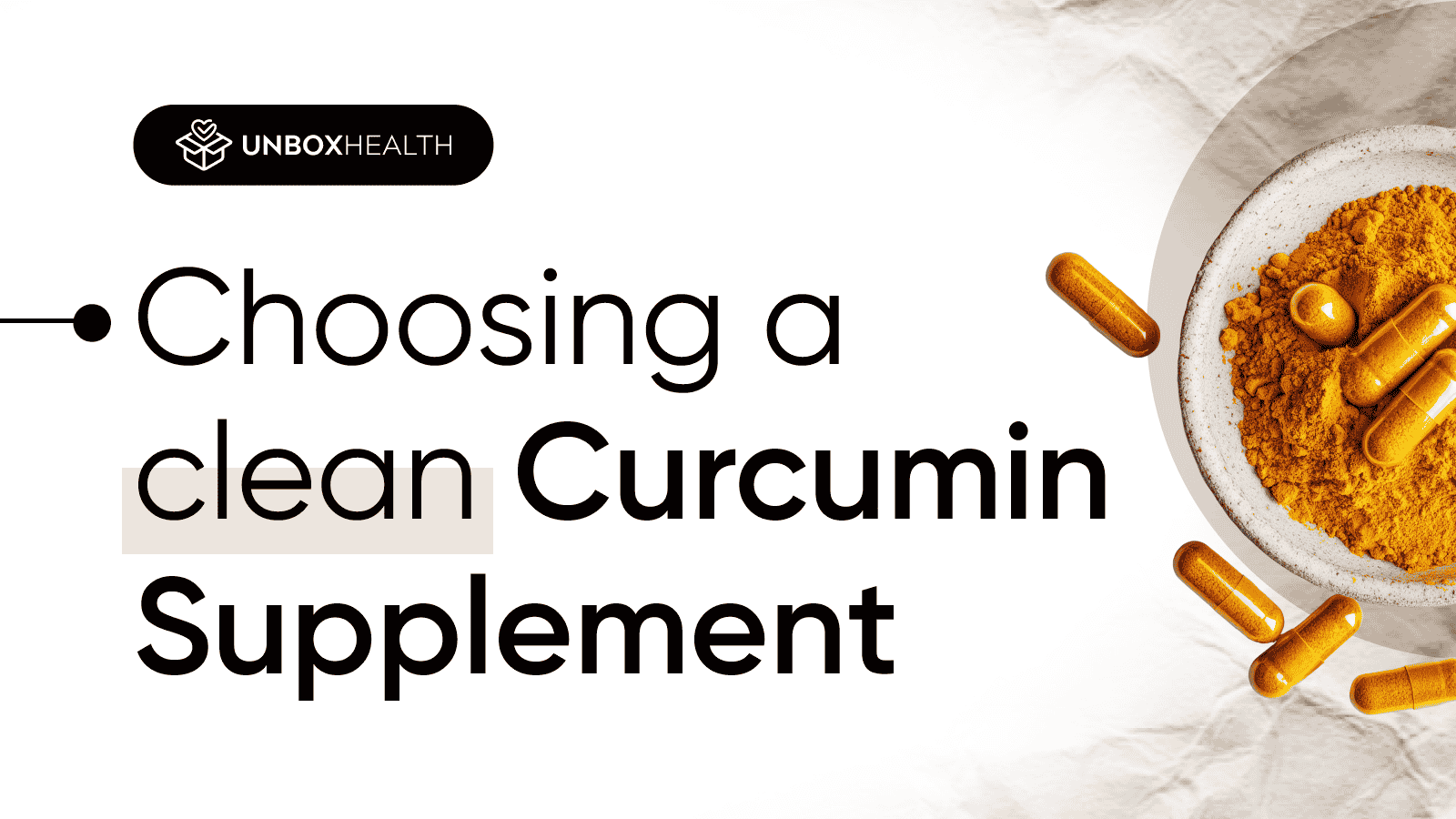Turmeric may be golden, but not all curcumin supplements are clean, effective, or even safe. This guide helps you make the right choice using only evidence from white papers and published clinical research.
1. What is Curcumin, and Why is Everyone Talking About It?
Curcumin is the main bioactive compound in turmeric, responsible for its deep yellow color and powerful antioxidant properties. While turmeric is widely used in cooking, curcumin has been studied for its role in supporting joint health, cardiovascular function, immune balance, and gut health.
However, there’s a problem. Curcumin by itself is poorly absorbed, and many supplements on the market are contaminated with heavy metals or make unproven claims.
2. What Are the Scientifically Proven Benefits of Curcumin?
Research-backed benefits of curcumin include:
- Joint and Musculoskeletal Health: Supports a healthy inflammatory response and helps ease non-chronic joint discomfort [1].
- Cardiovascular Health: Helps maintain normal cholesterol levels and supports endothelial health [1].
- Gut and Liver Health: Promotes the growth of beneficial gut bacteria and protects liver cells from oxidative damage [2][3].
- Immune Function: Modulates cytokines and supports immune cell activation [4].
- Antioxidant Activity: Scavenges free radicals and enhances antioxidant enzymes like SOD and GSH [4].
3. Why is Curcumin Absorption from Turmeric So Low?
Curcumin has poor oral bioavailability due to:
- Low solubility in water
- Tight binding to mucus in the gut
- Rapid metabolism into inactive forms
- Quick elimination via bile and urine
- Minimal reabsorption in the colon
In most cases, less than 1 percent of orally consumed curcumin is absorbed into systemic circulation [4].
4. What Improves Curcumin Absorption?
Several strategies can significantly enhance curcumin’s bioavailability:
- Piperine (from black pepper) inhibits curcumin’s breakdown, increasing absorption by up to 2000 percent [5]
- Fatty meals or turmeric oil help improve solubility since curcumin is fat-soluble
- Advanced formulations like liposomes, nanoparticles, and micelles protect curcumin and aid absorption [4]
- Tetrahydrocurcumin, a more stable metabolite of curcumin, is better absorbed and more effective in some cases [4]
5. What Types of Curcumin Supplements Are Available?
| Form | Pros | Cons |
|---|---|---|
| Powder | Versatile | Bitter, poorly absorbed |
| Capsules/Tablets | Convenient dosing | May contain fillers |
| Liquid/Tincture | Faster absorption | Often tastes unpleasant |
| Sprays/Ointments | Topical use | Limited systemic effect |
| Liposomal/Nano Formulations | Best absorption | Higher cost |
6. What Should I Look for on the Label?
Always check for:
- Standardization to 95 percent curcuminoids
- Presence of piperine or bioavailability enhancers
- Mention of tetrahydrocurcumin or nano delivery technology
- Third-party lab testing for heavy metals and label accuracy
7. Can Curcumin Supplements Contain Heavy Metals?
Yes. In fact, several studies have reported lead chromate contamination in turmeric sourced from Gujarat and Andhra Pradesh [6]. Lead, arsenic, mercury, and cadmium are common contaminants if the product is not lab-tested.
Contaminated turmeric can pose long-term health risks, especially when consumed daily as a supplement.
Yes. In fact, several studies have reported lead chromate contamination in turmeric sourced from Gujarat and Andhra Pradesh [6]. Lead, arsenic, mercury, and cadmium are common contaminants if the product is not lab-tested.
Contaminated turmeric can pose long-term health risks, especially when consumed daily as a supplement.
8. What Makes a Curcumin Supplement Truly “Good”?
| Feature | What to Check |
|---|---|
| Bioavailability | Uses piperine, liposomes, micelles, or tetrahydrocurcumin |
| Curcuminoid Content | Should list actual amount, ideally ≥95 percent extract |
| Contaminant-Free | Tested for heavy metals like lead, arsenic, cadmium, mercury |
| Transparent Labeling | No hidden ingredients, clear dosage instructions |
| Research-Based Claims | Avoid miracle cures, stick to proven benefits |
9. Are All Bioavailable Forms the Same?
No. There are three generations of bio-enhanced curcumin:
- First-generation: Uses piperine or turmeric oil to delay breakdown.
- Second-generation: Emulsifiers, phospholipids, or carbohydrate complexes improve solubility.
- Third-generation: Tetrahydrocurcumin or micelle technologies enable higher absorption without synthetic emulsifiers [4] Tetrahydrocurcumin is considered one of the most bioavailable and pharmacologically potent forms of curcumin [4].
10. Why Trust Unbox Health for Supplement Ratings?
Because we test what others only claim. At Unbox Health, we independently test popular curcumin supplements for:
- Total curcuminoids
- Piperine or enhancer presence
- Heavy metals: Lead, Arsenic, Cadmium, Mercury
- Label Accuracy vs Actual Lab Results
Check out unbiased lab-tested ratings of “Curcumin Supplements” on Unbox Health along with their detailed lab reports.
About Unbox Health
Unbox Health: India’s First Ratings Platform for Packaged Foods and Health Supplement Tired of biased reviews and never-ending claims? At Unbox Health, every product is tested at multiple premium FSSAI-approved NABL-accredited international labs – 100% independently, transparently, and without any brand involvement.
- 100% Transparency: All lab reports are publicly published.
- Zero Hidden Agendas: Products are market-bought with no brand involvement.
- Accurate Testing: Samples tested at up to 3 premium international labs
- Actionable Ratings: Based on Label Accuracy, Toxicity & Nutritional Profile.
Head over to Unbox Health and let the data guide your consumption choices.
References:
- Wongcharoen W, Phrommintikul A. The protective role of curcumin in cardiovascular health. Int J Cardiol. 2009;133(2):145–151. doi:10.1016/j.ijcard.2009.01.073
- Dulbecco P, Savarino V. Therapeutic potential of curcumin in digestive diseases. World J Gastroenterol. 2013;19(48):9256–9270. doi:10.3748/wjg.v19.i48.9256
- Vera-Ramirez L, et al. Curcumin’s role in hepatic protection. BioFactors. 2013;39(1):88–100. doi:10.1002/biof.1057
- Aggarwal BB, et al. Curcumin vs tetrahydrocurcumin in bioavailability and cellular activity. Molecules. 2014;20(1):185–205. doi:10.3390/molecules20010185
- Shoba G, et al. Influence of piperine on the pharmacokinetics of curcumin in animals and humans. Planta Med. 1998;64(4):353–356. doi:10.1055/s-2006-957450
- Forsyth JE, et al. Turmeric adulteration with lead chromate in India. Environ Res. 2019;168:173–180. doi:10.1016/j.envres.2019.108720
- Hewlings SJ, Kalman DS. Curcumin: a review of its effects on human health. Foods. 2017;6(10):92. doi:10.3390/foods6100092
- Ghosh A, et al. Label discrepancies in turmeric supplements. J Diet Suppl. 2020;17(5):522–532. doi:10.1080/19390211.2020.1735335
